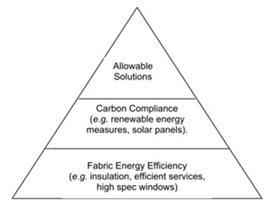The public may not understand what a zero carbon home is but that doesn’t mean it shouldn’t deliver for them

A member of the general public will find a “zero carbon” home a difficult concept to understand. The current definition is a design that produces a Part L CO2 output of zero or less and is constructed tothose design requirements.
In reality, many dwellings cannot be designed and constructed to this standard within the site as the space cannot support the quantity of renewable energy generation required to offset the inherent CO2 emissions. Fortunately, these issues have been recognised and a solution developed by the Zero Carbon Hub is being adopted by the government.
The proposed approach is that if the new building meets a range of fabric energy efficiency standards and through additional on-site measures achieves a benchmarked minimum level of CO2 emissions, the residual carbon emissions can then be dealt with offsite via Allowable Solutions (AS).

In August 2013, the government issued a consultation called “Next Steps to Zero Carbon Homes – Allowable Solutions”, which explains the proposed delivery options for zero carbon. In summary they are:
- Achieve 100% zero carbon onsite. This will not be practical on all sites
- Allow the builder to abate the residual CO2 through improving existing buildings or producing renewable energy off site, this is called the DIY route
- Make a payment to a third party for them to deliver the CO2 abatement
- Make a payment to a fund which invests in projects that deliver CO2 abatement
At this point it’s worth standing back to consider how we can achieve best value for the customer, and how we can minimise the overall CO2 emissions from English homes (Scotland, Wales and Northern Ireland have very similar but slightly different regulations).
The customer in this context is the person who has bought the new home. If 100% CO2 abatement is provided on the dwelling their energy bills should be trivial - if not a potential source of revenue.
If the AS has been bought out or the DIY route is used, the home owner has paid for the abatement but not achieved the same level of reduced energy bill as the mitigation is offsite. In this situation the benefit of the investment will be held by a third party. Given the potential range of solutions and limited compliance auditing it will be difficult to ensure these investments have provided the maximum CO2 saving per pound spent.
If existing buildings have the biggest potential to save carbon and if we want to wisely spend the money on audited, best value CO2 savings we should restrict AS to a simple buy out mechanism. We could then collect the money across England and use it to offer everybody who has a Green Deal arrangement a 0% loan rather than the current rather expensive loan structure. This would address a key limitation in the Green Deal offer and hopefully increase take up. It could be branded “zero for zero”.
It may not address all the AS issues but it would focus on an area of real need, it would be audited and it would directly benefit the general public.
David Bownass is sustainability director at WSP



























No comments yet